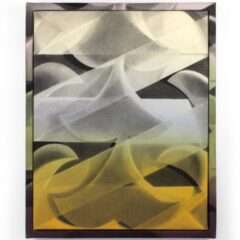It’s a different kind of silence than the refined quiet of an art gallery. Here at City Hall, the gentle ‘tap-tap’ of keyboards and the quiet shuffle of feet hurrying across carpeted floors reminds you, even as you take in Mark Stockton’s ludicrous charcoal portrait of Arnold Schwarzenegger and Tim Portlock’s hellish depiction of Philadelphia’s badlands, that you’re in the Office of Arts, Culture and the Creative Economy. Though I felt at first inhibited, I then reminded myself that the display of work by the Philadelphia artists chosen for the West Collection exemplifies the OACCE’s mission of furthering the arts in Philly’s civic life. While the “civic” aspect of art is not new for neither City Hall nor the West Collection (it began as an initiative at SEI, Al West’s financial services firm), this show represents a unique partnership. With the exhibition housed at the OACCE headquarters for six months, the artists chosen by Paige West for her family’s world-famous collection are imbued with an indelible sense of place. The exhibition is strong across the board. West, it appears, made an exhaustive study and selected an astonishing depth and breadth of Philadelphian artists for the show.
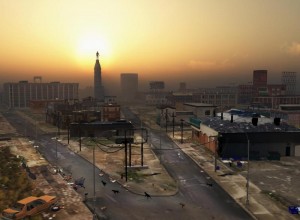
Tim Portlock’s works “Salon” and “Sunset,” my personal favorites of the group, face the door. I was immediately intrigued by the way both marry the ubiquitous societal themes of apocalyptic obsession and simulated video game reality to the very real violence, despair and desolation that permeates much of Philadelphia. The 3D simulations of the world through which he bikes regularly are stark, frightening, and unforgettable.
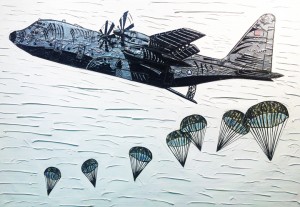
For Joe Girandola, duct tape is the miracle material, ubiquitous and utilitarian. But this isn’t necessarily a good thing: his three-dimensional drawings completely made with Duct Tape symbolize the kind of quick, shortsighted solutions to deep-seated problems upon which our society relies.
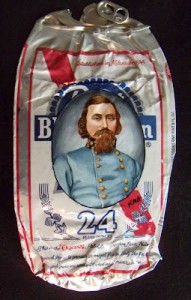
The White Trash Series, by Kim Alsbrooks, was born out of the artist’s tenure in the South. Perturbed by the region’s esoteric reverence for family myth, biased history and antebellum nostalgia, she painted museum-quality portraits onto flattened trash such as beer cans and grease-stained wax wrappers as parodies of embossed works on pearl and ivory, in the fashion of the pre-Civil War era. It’s a mean, but also hilarious and sobering way of deconstructing the idea of the social elite, both from the past and present.

Colette Fu’s vivid pop-up books and collage work takes a celebratory turn, with her astonishing photograph of the Yi Costume Festival in China resplendent in color and pageantry.
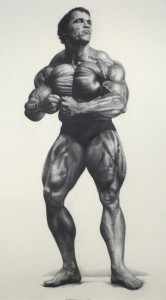
Several of the artists are avid collectors of memories and symbolically-laden objects. Astrid Bowlby’s dense works incorporate treasures made of people’s trash: balls of wool, odds and ends of fabrics, piles of leaves and miscellany are crucial to her implementation of everyday elements into her work. Kay Healy reaches for a place of universal nostalgia, and achieves it with large-scale screen prints of furniture that evoke the concept of childhood, whether her own or other people’s. Brian Richmond is another artist, like Portlock, who is entranced by the severity of the Philadelphia landscape and its surroundings. Mark Stockton is obsessed with the narratives we build around tragicomic celebrities, and honors that with his large scale drawings and prints. Employing a classical, meticulous style, his portrait of Arnold Schwarzenegger as “Mr. Olympia, 1974” is as impressively detailed as it is ludicrous and even pathetic.
In a similar spirit, Tim Eads’ take on a settler-style covered wagon brings out new, flashy and lurid. Erin Murray’s austere architectural paintings are against the door, the last thing you see before leaving the OACCE. They serve as portraits of buildings, heightening their features as well as the human stories they intimate. Their severity coexists with a soft duotone palette, as soothing as the facades themselves are imposing. With work from these artists in the OACCE space, as well as work spread over two additional floors, the West Collects 2012 selection is an honor both to the artists picked and to City Hall, offering the chance for Philadelphians to have their own stake in the world-famous initiative.



